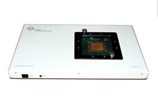Antares To Present The Effects Of Test Socket Contact-Resistance Measurement On IC Verification And Yield

 Santa Clara, CA and Phoenix, AZ - Engineers from Antares Advanced Test Technologies will discuss the effects of test socket contact-resistance (Cres) measurement on IC verification and yield at the ninth annual BiTS Workshop from March 9-12 at the Hilton Phoenix East/Mesa Hotel in Mesa, Ariz.
Santa Clara, CA and Phoenix, AZ - Engineers from Antares Advanced Test Technologies will discuss the effects of test socket contact-resistance (Cres) measurement on IC verification and yield at the ninth annual BiTS Workshop from March 9-12 at the Hilton Phoenix East/Mesa Hotel in Mesa, Ariz.
The Antares team will address how IC test engineers who operate without pin-specific Cres data during verification and production generally encounter increased ATE downtimes, shorter socket lifespans and prolonged root-cause analysis of IC failures and signal degradation, said David Weston, an Antares electrical engineer and program manager.
Weston said the regular measurement of socket Cres effectively gives test engineers the data to conduct socket verification, preventative socket maintenance and failure analysis that eliminates or establishes a socket as the root cause.
"When you don't know the true status of your socket contacts, it's difficult to determine the cause of reduced yield due to ATE failures," Weston said. "This lack of data leads to misallocating staff and equipment to perform troubleshooting that's completely unnecessary and drives down productivity."
Weston added that the Antares team at BiTS will demonstrate how their automated benchtop socket Cres tester, the CR-2600, allows test engineers to identify the level of electrical resistance on each individual contact in a socket array. The tester uses true 4-wire Kelvin techniques and a maintenance-free switching array to obtain accurate high-resolution measurements.
The socket Cres tester was designed to help IC test engineers at factories and test labs measure the effects of pin oxidization, contamination and wear that cause signal degradation and intermittent device failures.
Test engineers using the Cres tester place a shorting, or dummy device, into a test socket that is mounted on a custom adapter board. The adapter board, which mimics the socket footprint on the load board, is connected to the CR-2600 base unit. The circuitry housed in the portable device's base acquires the measurements and relays Cres data to a PC running companion software.
The software's graphical user interface (GUI) displays a color-coded matrix representing each contact in the socket and programmed electrical-resistance thresholds. The software allows engineers to save data and perform statistical analysis of resistance to gauge socket performance, contact degradation over time, as well as compare sockets and establish new resistance thresholds based on performance.
Engineers may use the Cres tester's handheld probe to pinpoint the location of bad contacts identified with the standard test sequence using a shorted device. When a contact is probed, the tester sends the location to the PC, which illuminates the contact on the GUI.
The Cres tester's key specifications and features include a form factor of 11" x 17", a resistance measurement range of 0 ohms to 300 ohms, accuracy of less than 5 mOhms, average measurement time of 25 pins per second and support of socket bodies up to 4" square and I/O matrixes of up to 51 X 51 (2,601 pins).
The Burn-in & Test Socket Workshop (BiTS) brings together semiconductor test professionals from more than 100 companies around the world to discuss the latest trends in the burn-in and test socket market.
SOURCE: Antares Advanced Test Technologies
